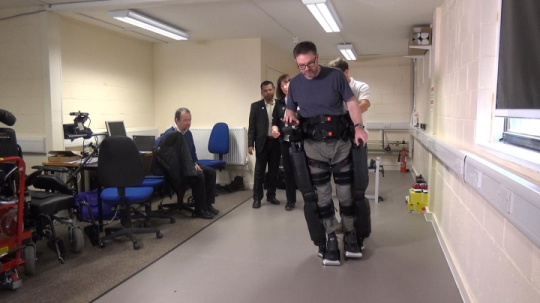Clinical Test of Rex Robotic Device as Rehabilitation Aid for MS Patients Starting in UK
Written by |

A clinical test of whether bionic robotics can improve mobility in people with relapsing or progressive forms of multiple sclerosis (MS) and considerable disability is now recruiting participants, after being approved by the U.K. National Health Service’s Health Research Authority (HRA) ethics committee.
 The trial, called RAPPER 3 (Robot Assisted Physiotherapy Exercises with Rex III), will be conducted at the Canterbury site of the East Kent Hospital’s University Foundation Trust (EKHUFT), and is expected to begin the first of 10 patient evaluations on April 19.
The trial, called RAPPER 3 (Robot Assisted Physiotherapy Exercises with Rex III), will be conducted at the Canterbury site of the East Kent Hospital’s University Foundation Trust (EKHUFT), and is expected to begin the first of 10 patient evaluations on April 19.
It will evaluate the feasibility and safety of using Rex Bionics‘ REX robot exoskeleton device as a hands-free rehabilitation aid for people with MS who have moderate to severely restricted mobility. The trial aims to have each patient complete a four-week “transfer, stand, balance, and walk” rehab program, and demonstrate better strength, improved balance and balance-related skills, and walking ability. Secondary trial goals include improved Multiple Sclerosis Walking Scale (MSWS-12) and the Multiple Sclerosis Impact Scale (MSIS-29) scores.
The trial is expected to end in August, and preliminary data to be presented later in 2017.
 Rex Bionics was founded by two British engineers in Auckland, New Zealand, where the company’s original robotic exoskeleton concept was designed in 2003. It was formally launched in 2010.
Rex Bionics was founded by two British engineers in Auckland, New Zealand, where the company’s original robotic exoskeleton concept was designed in 2003. It was formally launched in 2010.
REX engineers are working with rehabilitation experts to develop the concept and practice of robot-assisted physiotherapy (RAP), and the company offers the REX P version of its robotic mobility device designed for use at work or home, enabling wearers to walk and stand with their hands free.
 “We are optimistic about the REX’s potential for benefitting patients with multiple sclerosis,” Dr. Mohammed Sakel, study’s principal investigator and an East Kent University NHS FT Hospital’s consultant of neurorehabilitation Physician and Director of Neurorehabilitation Service, said in a press release. “I am delighted to see the enthusiasm of our MS patients and the Charity Kent MS Therapy Centre”
“We are optimistic about the REX’s potential for benefitting patients with multiple sclerosis,” Dr. Mohammed Sakel, study’s principal investigator and an East Kent University NHS FT Hospital’s consultant of neurorehabilitation Physician and Director of Neurorehabilitation Service, said in a press release. “I am delighted to see the enthusiasm of our MS patients and the Charity Kent MS Therapy Centre”
Crispin Simon, Chief Executive of Rex Bionics, added: “Our RAPPER II trial established the safety and feasibility of the REX in a single treatment. We are delighted that the specialists in Canterbury are now interested in exploring the use of REX in MS, and in a course of treatment over several weeks.”
Dr. Sakel explained to Multiple Sclerosis News Today that the patient group for RAPPER 3 differs from the group who took part in the RAPPER 2 trial reported on last May. The earlier trial was for people with spinal injury from any cause, while this is investigating people with relapsing as well as primary or secondary progressive MS, and with Expanded Disability Status Scale (EDSS) scores between 6 and 7.5. People with those scores either require a walking aid (6) or may be restricted to a wheelchair (at level 7.5, walking ability is limited to a few steps at best), Sakel said.
The RAPPER 3 intervention also differs from RAPPER 2, which had just one session to determine patient mobility with robot support. The upcoming trial will include four sessions of 45-minute exercise regimes, with assessments one week prior to and one week after the rehab program.
“We will assess whether their balance, confidence of balance, muscle spasticity, sleep, pain score improves or not,” Sakel said. “Therefore, the robot is not just acting as mobility aid, rather it’s acting as an aid to mobility rehabilitation.”
The goal, he said, is to allow patients to improve enough to gain independence from the need for “access to the expensive robot.” Investigators will also test “upper limb activity of daily living since [the] patient will be stable as well as mobile with hands-free.”
East Kent University hospitals are planning to two more clinical tests; one will be in MS patientsEDSS scores of 6 to 7.5 in which electronic biomarkers of muscle activation (such as surface EMG) will be assessed, along with spasticity, pressure distribution, and other parameters and the other in people with only mild disability (lower EDSS scores).
Asked how the REX mobility device can aid patients in ways that other mobility devices do not, Sakel noted that REX is the only hands-free robotic mobility device now available that allows wearers to do things with their hands while moving from point A to point B. That’s “very important,” he said. REX also mobilizes in all directions: forward, backward, turning, etc., for enhanced mobility around the house. It also can be used by patients, at home or in a clinic, with little to no use of their upper limbs.

Standing from left, Dr. Mohamed Sakel and clinical specialist Karen Saunders assist Steve Walker-Manuell in using the robotic legs. (Credit: University of Kent)
“Mobility as such is not enough,” Sakel said. “We need to see whether we could achieve mobility for a purpose, ie: going to kitchen [and preparing] a sandwich, without fear of falls.”
Sakel told Multiple Sclerosis News Today he plans to present preliminary research result either at the 2017 European Committee for Treatment and Research in Multiple Sclerosis (ECTRIMS) congress taking place in Paris in October, or at a future World Congress of Neurology meeting, and intends to publish the RAPPER 3 trial results in a peer-reviewed journal. “We will of course present in pw [people with] MS [and] families in the Kent MS Charity Centre where a large number of patients come as Day Centre visits,” he added.
Sources:
University of Kent
REX Bionics





